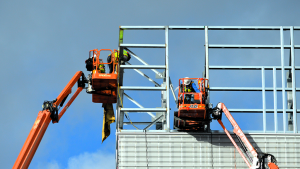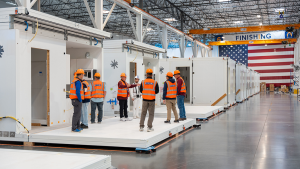What are the foundational technologies today on which we are building tomorrow?
That was the question Michael Hainsworth, executive producer of Futurithmic, co-host of the Geeks & Beats podcast and former BNN senior anchor and CTV news reporter, asked the audience at a talk billed Future Forward: Three Technologies That Will Change Our World Forever. The presentation was part of the CanaData construction forecasts conference held recently in Toronto.
“You look at 5G wireless, artificial intelligence (AI), augmented reality (AR), these are going to be three key technologies for your industry not for the next 10 years, not for the next 20 years, this is the future forever,” explained Hainsworth. “These fundamental technologies are going to give us things that today we can’t even predict.”
As society enters a phase termed Industry 4.0, augmented and virtual reality will be used for inventory management, site surveys and remote control, Hainsworth said.
“Blueprints are expected to become, to a degree, a thing of the past as we put on (AR) glasses or contact lenses and we just look around or we do that Minority Report Tom Cruise thing where we open our hands and the technology recognizes that’s the gesture for open blueprint,” said Hainsworth.
Hainsworth explained a challenge for construction workers in Tokyo, Japan is that like Toronto, Tokyo has two seasons: winter and construction. Another thing they have in common is the traffic.
“They’ve got these highly skilled crane operators who can’t get to the job site unless they haul their asses out of bed two-and-a-half hours earlier than everybody else,” said Hainsworth. “So today, some of them aren’t. When you combine augmented reality with 5G wireless what you get is the NTT Docomo remote control crane. So instead of climbing up into that perch, the people are sitting inside drone operator style rigs…they’re using it right now not just for cranes but they’re using it for controlling the actual diggers and all the other equipment on the ground.”
Autonomous weld inspecting robots are also on the horizon, combining AI with 5G.
“The work that is being done right now involves welding and somebody has to go back and check all those welds and it’s incredibly labour intensive,” said Hainsworth. “Right now, developments are underway on using artificial intelligence to recognize the difference between a good weld and a bad weld.”
There are many areas where AI can be valuable to the industry. For example, recruitment and HR systems, localization and mapping, machine/vehicular object detection /identification/avoidance and predictive maintenance.
“This is a massive one for your industry because you know when that machine breaks down it costs you money, it costs you time,” Hainsworth explained. “If you knew in advance when it’s going to die you can replace it.”
Artificial intelligence is pretty artificial and it’s not very intelligent, Hainsworth noted, adding the biggest hurdle to effective AI is bias.
“We talk about AI being possible because we have these massive data sets and data sets are where the problem lies,” he noted. “If we have data that is biased it’s going to spit out bad answers to questions we give it… Whatever data you have, you need a lot of it and you need to make sure that data that is being fed into that black box is accurate, auditable, and when the black box spits out an answer to a question you can verify that question has an answer that is reasonable.”
He also talked about how powerful 5G is going to be in the industry in the not too distant future. Companies are currently looking into the possibility of converting existing vehicles into fully autonomous equipment.
Another thing the construction industry might be interested in doing with 5G is network slicing.
“It’s the ability to slice off a piece of that 5G network and call it your own and only you have access to it,” Hainsworth explained. “This is very important for a bunch of reasons. Using dedicated bandwidth on your jobsite is necessary to ensure the autonomous construction equipment are moving the way it’s supposed to. It’s also incredibly secure.”
The biggest cost to the construction industry that can be reduced the most is worksite theft, Hainsworth told the audience. The estimated annual loss is $46 million in Canada $500 million in the U.S. AI such as facial recognition, autonomous drones and action recognition can be combined with 5G and edge computing to solve this problem, Hainsworth said.
“AI recognizes that Joe should be on the jobsite, he is qualified to be there, he’s an employee,” Hainsworth said. “The autonomous drone may find him wandering around the site late at night. That’s going to set off a red flag… Why is he loading stuff in the back of his truck? That is what the action recognition in artificial intelligence is going to accomplish as we work over the next five years to build those giant data sets.”
Follow Angela Gismondi on Twitter @DCN_Angela.











Recent Comments